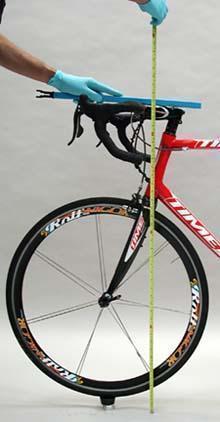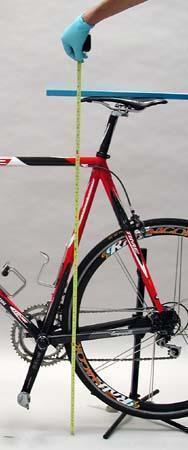

Recording road bike position
This article will describe the use of the Road Positioning Chart for competitive road bicycles. A similar article for MTB bikes is at MTB Bike Positioning. The chart is intended primarily for the mechanic to quantify and record the various aspects of a cyclist positioning adjustments. It can also be useful for a cyclist to track and record changes to his/her position. For example, if saddle height is raised, the new height and date of change can be noted. This will allow the cyclist to track changes in performance. Additionally, if the bicycle is lost or somehow destroyed, this chart will help in quickly setting up the new bike to closely match the original positioning.
The Road Positioning Chart can be downloaded as an Adobe® PDF file. The Adobe® Reader program is required to view and print this file. See Adobe® if you do not have this program.
Procedure
Useful tools for measuring rider position:
- Positioning Chart, plus pen or pencil
- Metric tape measure
- Angle finder
- Plumb bob
- Straight edge
- Measureing caliper
Begin with the bicycle on level ground. If possible mount bike on trainer and level bike by checking that both wheel axles are the same distance from the ground.
There is often more than one method for measuring a component or position. It is important that the user be consistent and that the method of measuring is noted. Record all units of measurement. For example, record "50cm" for fifty centimeters, and "50mm" for fifty millimeters. Complete the chart and makes notes with the assumption that someone else will need to set up a bike from only this chart.
Begin by recording customer/rider information, such as name, address, etc. Also record bike make, model, year of production, and serial number. Also record bike's color scheme and any unique or obvious physical characteristics that might distinguish this bike. Assume this will be used in a police report of a stolen bike. It is also recommended that the traveling rider carry a recent photo of the bicycle.
A: Saddle Height |
|
|
|
|
Record handlebar-over-saddle height difference. A simple method is to
measure perpendicularly from saddle to ground, and then bar to ground,
and take the difference between these two measurements. Use a straight
edge on top of the bars, and measure to lower edge of the straight edge.
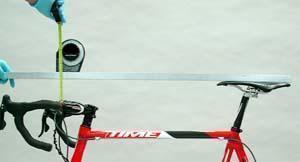 Another
option is to use a long straight edge and the level finder. Use level
finder to hold straight edge horizontal from saddle. Measure from lower
edge of straight edge to top of handlebars.
Another
option is to use a long straight edge and the level finder. Use level
finder to hold straight edge horizontal from saddle. Measure from lower
edge of straight edge to top of handlebars.
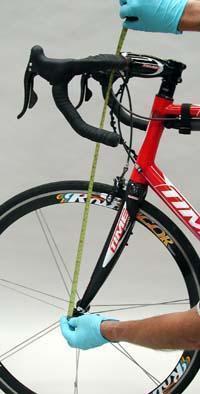 A
related option is to measure from the front axle to the top of the bars.
This is a useful measurement when tracking changes in position on the
same bike. However, this number is also related to stem length, fork
rake and wheel base, making it less useful when setting up a duplicate
position on a different frame.
A
related option is to measure from the front axle to the top of the bars.
This is a useful measurement when tracking changes in position on the
same bike. However, this number is also related to stem length, fork
rake and wheel base, making it less useful when setting up a duplicate
position on a different frame.
C: Saddle to Handlebar Reach
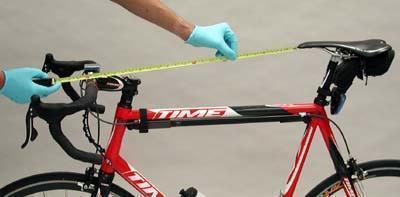 Measure
from saddle tip to the center of the bars at the stem. This gives a reference
for bar reach.
Measure
from saddle tip to the center of the bars at the stem. This gives a reference
for bar reach.
D: Saddle Angle or Tilt
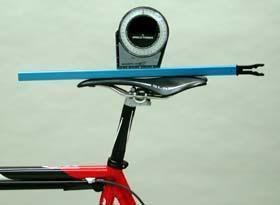 Using
a straight edge on top of saddle, measure saddle angle from horizontal.
If the front end of the saddle is raised, record this upward sloping saddles
as a positive number (+). Record downward sloping saddles with a negative
number (-).
Using
a straight edge on top of saddle, measure saddle angle from horizontal.
If the front end of the saddle is raised, record this upward sloping saddles
as a positive number (+). Record downward sloping saddles with a negative
number (-).
E: Saddle fore-aft
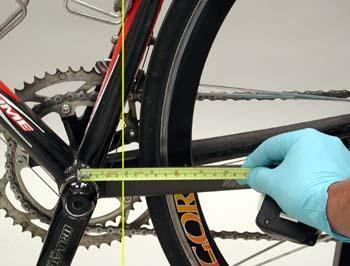 Drop
a plum bob line from the saddle tip and measure distance from line to
center of bottom bracket. It is easiest to tape line to saddle so it hangs
from saddle end and extends freely toward the ground.
Drop
a plum bob line from the saddle tip and measure distance from line to
center of bottom bracket. It is easiest to tape line to saddle so it hangs
from saddle end and extends freely toward the ground.
F: Saddle Brand and model
Record saddle brand and model.
G: Stem Length
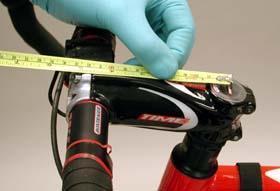 Measure
center of the stem binder bolt to the center of the bars.
Measure
center of the stem binder bolt to the center of the bars.
H: Stem Angle
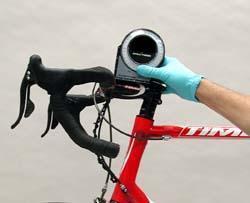 Record
the stem angle from horizontal. Especially on shorter stems, hold angle
finder so it is parallel to stem angle. In the stem is downward sloping,
record as a negative number ( - ). It stem is upward sloping, record as
a positive number ( + ).
Record
the stem angle from horizontal. Especially on shorter stems, hold angle
finder so it is parallel to stem angle. In the stem is downward sloping,
record as a negative number ( - ). It stem is upward sloping, record as
a positive number ( + ).
NOTE: Some stem manufacturers specify stem angle using the steering column
as a reference. If this angle is known, record this as well. It is possible
to measure the manufacturers angle by taking the stem angle and the quill
(steering column) angle. Stem angles sloping upward are recorded as positive
numbers, while stem angles sloping downward should be recorded as negative
numbers. For example, a bike is measured and the angle from vertical is
18-degrees. (This means the headtube angle as the bike sits is 72-degrees.)
The angle from horizontal is 25-degrees. The manufacturer's angle is then
90 - 18 + 25 = 97 degrees. In the right image below, assume the stem sloped
downward 6 degrees instead. The manufacturer's angle is then 90 - 18 +
(-6), or 66 degrees.
Manufacturer's angle = 90 - Angle from Vertical + Angle from Horizontal
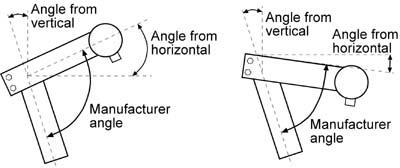
I: Handlebar brand and model
Handlebars vary in shape and design. Record the brand and model.
J: Handlebar Width
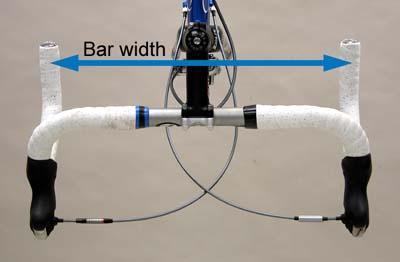 Measure
width from center to center at the lower section of the drops. Some manufacturers
specify width as an outside to outside dimension. However, when a bar
is wrapped with thick tape, this makes an accurate measurement more difficult.
Record method of measurement. For example, "46cm center-to-center". It
is use to know bar width when bike is crashed. The width after the crash
can be compared to the width before the crash. Replace bar if this measurement
is different.
Measure
width from center to center at the lower section of the drops. Some manufacturers
specify width as an outside to outside dimension. However, when a bar
is wrapped with thick tape, this makes an accurate measurement more difficult.
Record method of measurement. For example, "46cm center-to-center". It
is use to know bar width when bike is crashed. The width after the crash
can be compared to the width before the crash. Replace bar if this measurement
is different.
K: Handlebar Tilt or angle
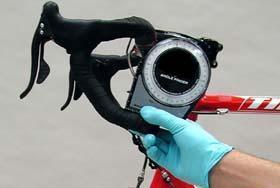 Measure
drop type bar angle off of lower section of drops using level angle finder.
Record any positive or negative angles to be consistent with the system
use on the stem. In other words, if the lower section is pointing downward,
or more toward the rear axle, record this as a positive number. If the
lower section is sloping upward, toward the rider, record this as a negative
number.
Measure
drop type bar angle off of lower section of drops using level angle finder.
Record any positive or negative angles to be consistent with the system
use on the stem. In other words, if the lower section is pointing downward,
or more toward the rear axle, record this as a positive number. If the
lower section is sloping upward, toward the rider, record this as a negative
number.
L: Handlebar Clip-on Bars or Aero Bars
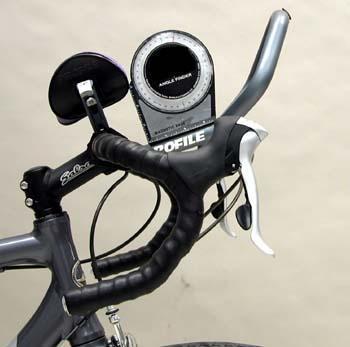 Measure
angle of aero-type extensions from horizontal. If the bar extension is
adjustable in reach, also record reach from bar center to end of extension.
Measure
angle of aero-type extensions from horizontal. If the bar extension is
adjustable in reach, also record reach from bar center to end of extension.
M: Brake Level Position
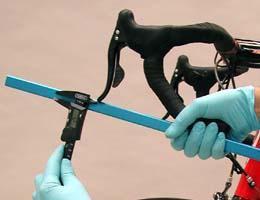 Record
position of brake levers on handlebars. Place straight edge on lower drops
and measure tip of lever as above (+) or below (-) this line.
Record
position of brake levers on handlebars. Place straight edge on lower drops
and measure tip of lever as above (+) or below (-) this line.
N: Crank Length
Record crank length. Cranks are measured from the center of the pedal
mount to the center of the spindle square. Arm length in millimeters is
typically labeled on the back of the crank.
O: Chainring Sizes
Record the preferred large and small chainring sizes.
P: Pedals
Record the pedal make and model. Changing pedal types may affect the saddle
height.
Q: Shoes
Record shoe size, make, and model. It is also useful to record user preference
of either a fixed or floating type of cleat. The cleat position on the
sole may also be recorded.
Rotation: Engage shoes on pedals, without rider. Hold shoe parallel to crank. Measure distance from crank bolt to center of shoe sole. If the pedal has adjustable float, hold sole in middle of float range. If cleat has float, hold sole toward crank.
Fore-Aft: Record cleat fore-aft position on sole by measuring from tip of sole to cleat.


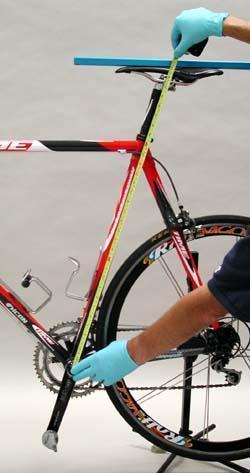 Record
saddle height and note method of measurement. A simple method is to place
a straight edge on top of the saddle and record height from the bottom
bracket center to the lower edge of straight edge. Measure along the seat
tube.
Record
saddle height and note method of measurement. A simple method is to place
a straight edge on top of the saddle and record height from the bottom
bracket center to the lower edge of straight edge. Measure along the seat
tube.